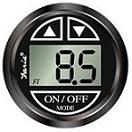What is a depth finder used for?
The technology used in depth finder originated during the World War II when solar technology was invented to give the Allied powers advantage over the Axis’ elusive submarines. This same technology is being used today to aid anglers catch fish lurking under the water.
A depth finder, also called a fish finder, is a hi-tech fishing tool that uses sonar (Sound Navigation & Range) to detect the bottom of the water and fish, displaying them on a remote display screen for the angler to see. 
A device attached to the bottom of the watercraft transmits sonar waves through the water below, and when they hit an object, whether a fish or waterbed, they bounce back. The transmitter receives the signals back and analyzes them, displaying its findings on a small display screen. The screen then provides a visual representation of the underwater including the objects and waterbed underneath the watercraft. Depth finder technology is so advanced these days that they could distinguish between objects like seaweeds, waterbed, trash, and of course, fish; and represent them with instantly-recognizable symbols on the screen.
For anglers, they hope that their depth finder will bounce back signals of an elusive fish. Because anglers are given an approximate picture of the underwater, it could allow them to know the location of the fish. Most depth finders today could also provide an estimated depth of the fish, thus, also allowing anglers to know how deep their lures should be. The ability of the depth finder to determine the depth of the bottom of the sea or lake, also allows anglers to refrain from wandering off into shallow waters that could damage their boats.
There are several manufacturers of depth finders today including Eagle, Furuno, Garmin, Humminbird, Lowrance, Magellan and Raymarine. Some of the models sport the latest in scientific advancement such as GPS technology and electronic compass displays among others.






